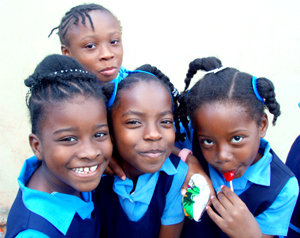
Long ago, my family and I spent our Easter holidays on the Spanish island of Mallorca. One of my little sons suddenly asked an interesting
question: "Why are we speaking Dutch in Spain?" He thought we should have changed languages immediately after our arrival on Mallorca, and he couldn't accept that all
people knew Spanish except us.
This question about speaking Dutch made me ponder: In which countries besides the Netherlands and Flanders is Dutch the main language?
Fragments of old folk songs leapt into my mind ...

Let's begin with the former Dutch colonies 'in the West'. On the little isles of Sint Maarten, Saba and Sint Eustatius, Dutch is
the official language, but everybody speaks English most of the day. On the larger islands of Aruba, Bonaire and Curaçao, the colloquial language is
Papiamento, but most people speak Dutch as well. Until recently, Dutch was the only official language there.
In Surinam, too, most people speak two languages: besides Dutch, they speak Sranan Tongo or Hindi or Malay
or some other language. This corresponds with the ethnic descent of the speakers from Africa or India or Java, etc. Through the centuries, Surinam has become a
medley of languages: Mi lobi joe, Paramaribo - I love you, Paramaribo.
In the former Dutch East Indies, now Indonesia, many old people still speak Dutch, but the everyday language is Malay.
This Malay language absorbed a lot of Dutch words in a somewhat corrupted form. Examples: belasting (taxes), gratis, kantor (office), kwitansi (receipt),
loket (ticket window), oma (granny), tanpasta (tooth paste), etc. Singer Wieteke van Dort, among others, keeps alive our memories of 'tempo doeloe', the good old
days in 'Indië'.
In colonies of very long ago, like Ceylon (Sri Lanka) or Pernambuco (in Brazil), the loanwords from Dutch are even more corrupted.
But 'burgher' is still a well-known word in Sri Lanka. And everybody knows that New York has a city district called Brooklyn, whose original name in its Dutch years was
Breukelen.
However, there is one Dutch ex-colony where a sort of Dutch is the mother language of many people since four centuries: South Africa.
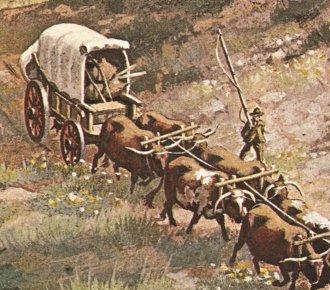
Now that the Netherlands have qualified for the world championships of soccer, next summer in South Africa,
I see on teletext that the matches will be played in cities with old Dutch names: Johannesburg, Rustenburg, Bloemfontein. These lie in the provinces of
Transvaal and Oranje Vrijstaat (Orange Free State), where the Boers of Dutch descent trekked to with ox-wagons from the old colony on the
coast in the nineteenth century. Until the early years of the twentieth century, they stood firm, under the leadership of president Paul Kruger, against the English 'rooineks
(rednecks)'.
If the Netherlands won't stand firm in the football championships, we can also cheer for the South African team, in which the leading midfielder Steven Pienaar
proudly bears his Boer surname.
Dutch people know that the first language of millions of South Africans is African, a daughter language of Dutch.
At school we learnt songs in African: for example, "My Sarie Marais" and "Bobbejaan" and "Ossewa", a song about the ox-wagons which the Boers used to trek to
Transvaal.
In old reading books for children, the little boys Puk and Muk are hopping around on the fields of "uncle Paul and aunt Sarie", and climbing over the South African
mountains called "Drakensberge" (Dragon mountains).
We also learnt how our language has landed in Africa: Jan van Riebeeck founded there in 1652 the Cape Colony, the Dutch colony near the Cape of Good Hope that was
to become Cape Town.
There are even more speakers of African in the Cape Province and in Namibia than in Transvaal and Oranje Vrijstaat.
Nowadays, less than one half of the speakers of African are white. So there are whole negro communities that speak a dialect of Dutch!
But in some German villages, the language sounds almost Dutch, too. Just listen:
Nach Ostland wollen wir reiten - It's to Eastland we wish to ride
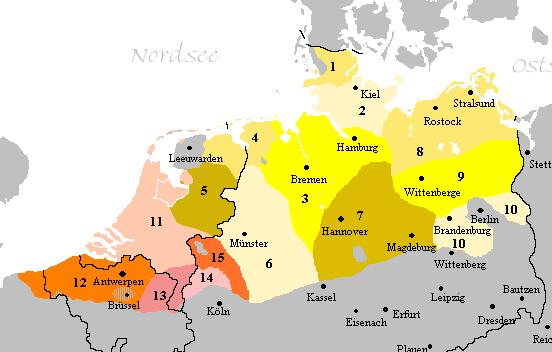
My mother-in-law was born in Germany, near Oldenburg. Her own mother died when she was eleven.
In those years about 1920, many girls from the north of Germany emigrated to work in "rich Holland". Our Else was even luckier: a good family in the Dutch
province of Groningen adopted her as a daughter. She could go to school in that Groningen village at the day of her arrival.
Language was hardly an obstacle, because the dialect was the same at both sides of the border between the Netherlands and Germany. However, Else must have
said at least one strange word, because her classmates said to each other: "Dat wicht zegt tegen neus van Nase - That child says Nase instead of nose".
But my mother-in-law knew a song her class mates knew as well: "Naar Oostland willen wij rijden - It's to Eastland we wish to ride".
In the middle ages, these Eastland riders brought the Low German and Dutch languages all the way to Russia!
As a matter of fact, the dialects in the north of Germany strongly resemble Dutch. This holds true for the dialects of Low German, to the north of the
Benrather Linie, that is the line that separates "maken" (make) from "machen". See the map above, which marks all dialect groups of Dutch and Low German.
The map shows that Kerkrade speaks, of old, a dialect of High German! Maastricht does lie at the 'good' side of the Benrather Linie, but at the 'wrong' side of the
Uerdinger Linie, which separates "ik" (I) from "ich".
According to the map, the Frisian tongue of Leeuwarden and its surroundings is a separate Germanic language.
People from the east of the Netherlands can talk in their dialects with the neighbours at the other side of the border, without any problems. However, the dialects
in the north of Germany have to make room for High German, which is used at school and in the newspapers and on television. Likewise, the Dutch dialects have to
make room for 'general civilized' Dutch. So the border between the countries is ever more becoming a boundary between languages.
As to language boundaries ... In Belgium, our southern neighbour, there is a language boundary that weighs upon the country like the legendary millstone around the neck
of the steed Bayard.
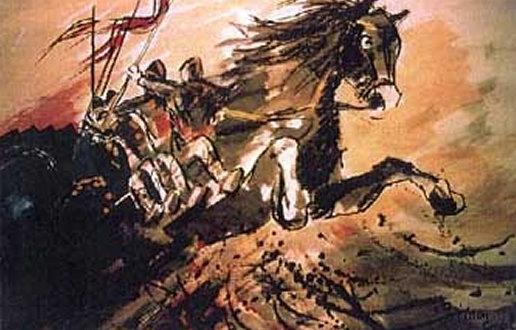
In Belgium, the language boundary between Flemish Dutch and
Walloon French runs from east to west through the middle of the country. Since the birth of Belgium as a state in 1830 until the years 1960, there has been a
social language barrier as well: French was the language of the high society. Nowadays there is still a bitter fight for every inch of the physical language boundary and
every comma in the corresponding documents. This especially applies to the area around Brussels, which has become almost French.
Will the country, like Bayard, rise above the water up to three times and finally perish?
Formerly, the language boundary ran on until the French coast, so that Dunkerque and its neighbour towns were speaking Flemish.
But there were boards standing on the beach on which it said: "Interdit de parler Flamand" - Speaking Flemish is not allowed.
Nowadays, the local Flemish dialect in French Flanders is only a hobby for amateurs.
Now is that Flemish common Dutch? Yes and no. Flemish writers often win Dutch literature prizes, and Flemish readers often win the Dutch national spelling
contest. But the Flemish television channels subtitle the Amsterdam police series Baantjer ... in Dutch! I can immediately hear whether a television presenter
is Flemish or Dutch, because of the differences in accent and sentence structure and choice of words. Dutch people don't immediately understand what the Flemish
politician Kris Peeters means by saying "he won't let people play with his feet". A Dutchman would say "he won't let people consider him the fool".
Nevertheless, the Flemish and Dutch languages stem from the same Frankish branch of the Dutch and Low German language families. We learnt at school
three Germanic tribes occupied our country after the Roman era: the Franks, the Frisians and the Saxons. See the map below. In the fifth and sixth centuries,
many Frisians and Saxons and Angles and Jutes crossed the sea from the coast in the north of 'the lowlands of Germania' to the island that was to
become the new 'land of the Angles' - England.
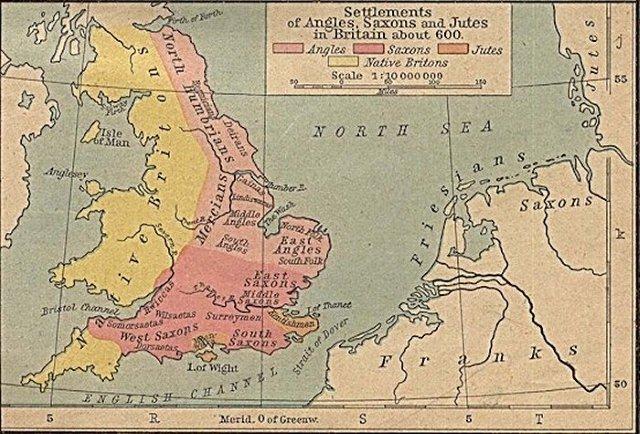
It's quite a long way to Tipperary in Ireland, the Anglo-Saxons only got to England. But their language is now spoken all over the world.
To which degree is English still akin to Frisian and Low German?
Frisian and English form a separate branch of the family of West-Germanic languages. Rumour has it that the Frisian pirate Greate Pier, about the year 1500,
checked whether a captive was a real Frisian by letting him repeat: "buter, brea en griene tsies". This sounds exactly the same as "butter, bread and green cheese",
and it also means the same, so a modern Englishman would come out of this test alive.
English speech underwent many influences in the course of history, successively of Celtic British, Latin, Norse and Danish, French, and many other languages.
And Dutch underwent many influences, too. But the kernels of English and Dutch are still closely akin: If a tourist from Holland says in England
"'t Is een lange weg tot Tipperary", the English people will kindly understand him.
However, if he recklessly says at breakfast he wants "boter, brood en groene kaas", the landlord will gesture, like Greate Pier, that the head of this tourist should be cut
off.
How many people in the world speak Dutch today? If we neglect the number of immigrants that did not yet sufficiently integrate, there are sixteen million Dutch.
Furthermore, there are six million Flemish and six million speakers of African. We can't include any people from modern Germany or modern England.
Including the speakers of Dutch in the old colonies in the West and in the East, there are twenty-nine million speakers of Dutch altogether.
Who cares? If we keep trying a bit harder, all people will eventually understand each other ... in English!
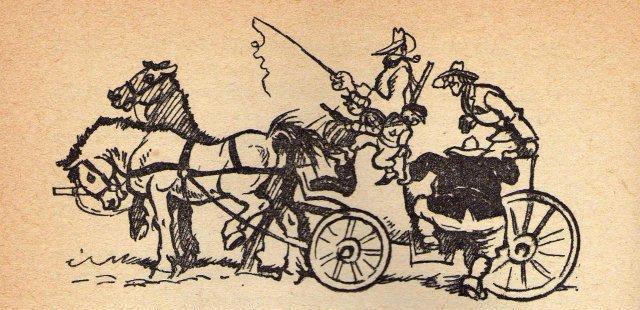
Sources:
1) WINKLER PRINS Encyclopedie and Wikipedia under (Dutch equivalents of) Papiamento, Sranan Tongo, Dutch in Indonesia, Afrikaans, Paul Kruger,
Jan van Riebeeck, Nederduits (Low German), Benrather Linie, Frisian, Belgium, Dunkirk, Anglo-Saxons, Pier Gerlofs Donia, etc.
2) Groot VAN DALE Leenwoordenboek, Nicoline van der Sijs, van Dale Utrecht/Antwerpen 2005 (This is a Dutch dictionary of loanwords,
with an article on the exact differences between Low German and High German.)
3) Puk en Muk door Afrika 1, Frans Fransen, RK het Jongensweeshuis Tilburg 1952 (This is a Dutch reading book for children.)
4) Some of the songs I took fragments from, to place them above the pictures:
* My Sarie Marais: http://www.youtube.com/watch?v=r7c83DqE9WY (Jim Reeves sings the song, and the Dutch lyrics appear in the same video.)
* Naar Oostland: http://ingeb.org/songs/naarostl.html (On this page you find a midi-file of this song, and the Dutch lyrics of it.
It's to Eastland we wish to ride, for in Eastland there is a better place for us to live. )
* Tipperary: http://www.firstworldwar.com/audio/itsalongwaytotipperary.htm (On this page you find links to three singers who sing the song, and the lyrics in
English. It's a long way to Tipperary, to the sweetest girl I know.)
5) You can find some more of the songs I took fragments from at http://www.liedjeskist.nl/liedjesthema/themablad.htm .
(This is a box containing the Dutch lyrics of many songs, and the staff notation of the music of these songs. If you don't mind downloading QuickTime,
you can even hear the music by clicking on the staff notation.)
It includes:
* Under B: Bobbejaan klim die berg (Bobbejaan climbs the mountain to fight the Rooinek.)
* Under P: Pak al je zorgen in je plunjezak (Pack all your worries into your kit bag and whistle a song. Why should you worry if it doesn't help you anyway?)
* Under R: 't Ros Beiaard (The steed Bayard carries the four sons of Aymon on its back in the Frankish epic about these 'vier Heemskinderen' who fought Charlemagne.)
* Under R: Ry maar an, ossewa (Ride steadily on, ox wagon, my darling is waiting by the path to Ouweland.)
* Under S: Sarie Marais (My Sarie Marais is so far from my heart, but I hope to see her again. She lived in the village next the river Mooirivier, before the war began.)
* Under W: Waar de blanke top der duinen - Ik heb u lief mijn Nederland (Where the white tops of the dunes are shining in the glow of the sun -
I love thee dearly, my Netherlands.)
6) Surinam national anthem: http://www.surimaribonet.com/volkslied.html (The anthem is sung, and the Dutch and Sranan Tongo lyrics appear in the same video.)
7) Wieteke van Dort as aunty Lien from good old Dutch East India: http://www.youtube.com/watch?v=1vm5JcdHgew&feature=related
(Aunty Lien sings a wistful song whose Dutch lyrics appear in the same video. It's about the Hague as the 'widow of Indië'.)
8) "O Nederland, geef mij rijst met kouseband; wat moet ik anders eten in dit koude kikkerland? - O Netherlands, give me rice with butter beans; what else
should I eat in this cold frogland?"
I'm sorry I couldn't find this merry little song of Max Woiski jr on the internet.
But I did find http://pieterinsuriname.wordpress.com/2008/07/09/mi-lobi-joe-mi-sweet-paramaribo/ .
If you need additional info, please contact me at info@petericepudding.com .
(I received a couple of mails from an Englishman who lived in Holland as a child, studied German afterwards, and is living in Scotland since twentyfive years.
He remarks Scottish English underwent less French influences than English English, and hence stayed purer Anglosaxon, especially in and around Fife.
He gives diverse examples of Scottish-English phrases that Dutch and Frisians and northern Germans understand better than non-Scottish speakers of English.)
(Maastricht, June/July 2009, H.Reuvers)